Have you ever wondered how Amish farmers maintain those picture-perfect gardens year after year? We’ve gathered some time-tested wisdom from these masters of traditional agriculture that’ll transform your gardening experience.
The Amish community has perfected sustainable gardening techniques through generations of hands-on experience, without relying on modern technology or chemical answers. Their methods aren’t just effective—they’re environmentally friendly and budget-conscious too. From companion planting to natural pest control, these techniques have stood the test of time for good reason.
Let’s jump into these valuable Amish gardening secrets that’ll help you grow healthier vegetables, maintain more productive soil, and create a more harmonious garden network. These tips might be centuries old, but they’re exactly what today’s gardeners need.
7 Time-Tested Garden Tips From Amish Farmers
1. Companion Planting for Natural Pest Control
Amish farmers excel at strategic plant placement throughout their gardens. They’ve mastered the art of companion planting by positioning mutually beneficial plants near each other to naturally repel pests and improve growth. Marigolds are frequently planted alongside tomatoes to deter nematodes and other harmful insects. Basil companions well with tomatoes not only for pest control but also to enhance flavor. Beans and corn create a beneficial relationship when planted together, as beans fix nitrogen in the soil that corn heavily uses.
2. Natural Fertilizers and Soil Amendments
Amish gardeners rely exclusively on organic materials to nourish their soil. They routinely use composted manure from their farm animals as a primary fertilizer source. Wood ash from their stoves provides essential potassium and helps neutralize acidic soils. Compost made from kitchen scraps, fallen leaves, and garden waste creates rich humus that improves soil structure. Crop rotation practices prevent soil depletion and minimize pest problems across growing seasons.
3. Water Conservation Techniques
Amish farmers carry out thoughtful irrigation systems that maximize water efficiency. They often use deep watering techniques that encourage plant roots to grow downward, increasing drought resistance. Rain barrels positioned at downspouts collect valuable precipitation for later use during dry periods. Mulching around plants with straw or hay significantly reduces evaporation and retains soil moisture. Morning watering schedules allow plants to absorb moisture before the heat of the day causes excessive evaporation.
4. Hand Tools and Manual Cultivation
Traditional hand tools remain the backbone of Amish gardening practices. High-quality, well-maintained hoes allow for precise weed control without disturbing vegetable roots. Broad forks aerate soil deeply without inverting layers, preserving the soil’s natural structure. Hand-pulled wagons transport heavy loads of compost, mulch, and harvested vegetables efficiently. Simple watering cans with rose spouts distribute water gently to prevent soil erosion and seed displacement.
5. Season Extension Methods
Amish gardeners employ clever techniques to extend their growing seasons without electricity. Cold frames constructed from salvaged windows protect young seedlings from late spring frosts. Row covers draped over simple hoops shield plants from both cold temperatures and insect pests. Strategic planting on south-facing slopes allows plants to capture maximum sunlight during cooler months. Hardy vegetable varieties selected through generations of seed saving tolerate temperature fluctuations better than many modern hybrids.
6. Seed Saving and Heritage Varieties
Preserving genetic diversity through seed saving represents a cornerstone of Amish gardening tradition. They carefully select the strongest, most productive plants for seed collection each season. Paper envelopes labeled with variety names and harvest dates store dried seeds until the next planting season. Community seed exchanges allow families to share successful varieties and maintain genetic diversity. Heirloom vegetables with proven performance in their exact climate and soil conditions remain favored over commercial hybrids.
7. Natural Pest Management Strategies
Amish farmers deploy many non-toxic approaches to manage garden pests effectively. Diatomaceous earth sprinkled around susceptible plants creates a barrier against crawling insects without harmful chemicals. Soap sprays made from pure castile soap and water suffocate soft-bodied pests like aphids on contact. Hand-picking larger pests like tomato hornworms occurs during daily garden inspections. Floating row covers physically block flying insects from accessing crops during vulnerable growth stages.
Embracing Natural Fertilizers And Soil Management
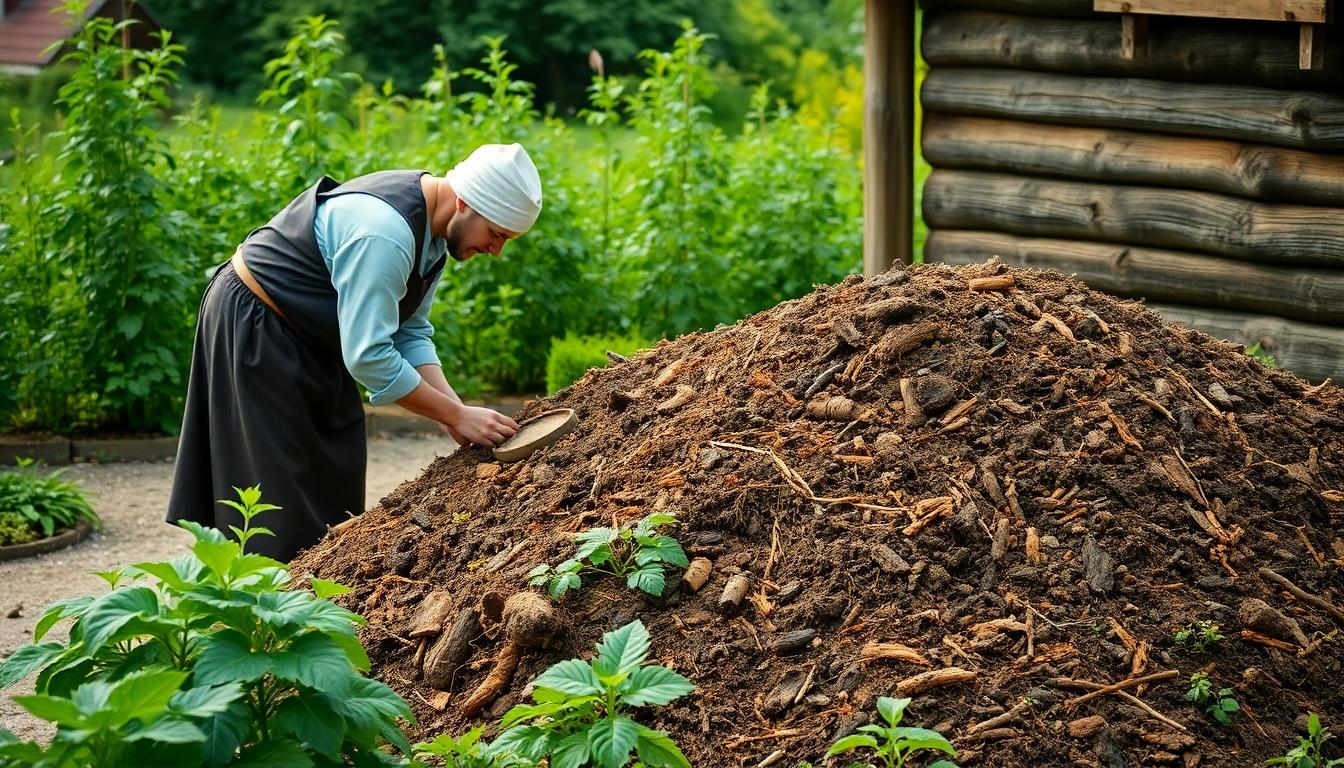
Amish farmers excel at maintaining soil health through time-tested organic methods that avoid synthetic chemicals. Their approach focuses on working with nature rather than against it, utilizing readily available resources to create sustainable fertility cycles.
Creating Nutrient-Rich Compost The Amish Way
Composting is a cornerstone of Amish garden fertility management. Weeds and organic materials are carefully layered in compost piles alongside animal manure to create a balanced decomposition process. This methodical layering technique accelerates the breakdown while preserving nutrient density, typically producing rich, humus-filled compost within just a few months. Amish gardeners maintain optimal microbial activity by regularly turning their compost piles and monitoring moisture levels. The resulting fertilizer delivers powerful plant nutrition without relying on any synthetic additives. Many Amish families include kitchen scraps and crop residues in their compost, ensuring nothing goes to waste while building soil fertility.
Using Animal Manure Strategically For Better Yields
Livestock manure serves as the primary fertilizer in Amish farming communities. Cattle and poultry manure are particularly valued but must be properly aged or composted before application to prevent nutrient burn on plants. Amish farmers often mix manure with straw or other carbon-rich materials to achieve an ideal nitrogen balance before incorporating it into their garden soil before planting. This practice not only enriches the soil with essential organic matter but also significantly boosts beneficial microbial populations that sustain long-term fertility. Crop rotation works hand-in-hand with manure application in Amish gardens, effectively minimizing pest buildup while maintaining consistent soil health across multiple growing seasons. For soil structure improvement, some Amish gardeners add crushed hardwood charcoal (about 2 cups per cubic foot) to enhance water retention and microbial activity, while pine needles are chopped and mixed with compost to adjust soil pH for acid-loving crops like berries.
Practicing Companion Planting For Pest Control
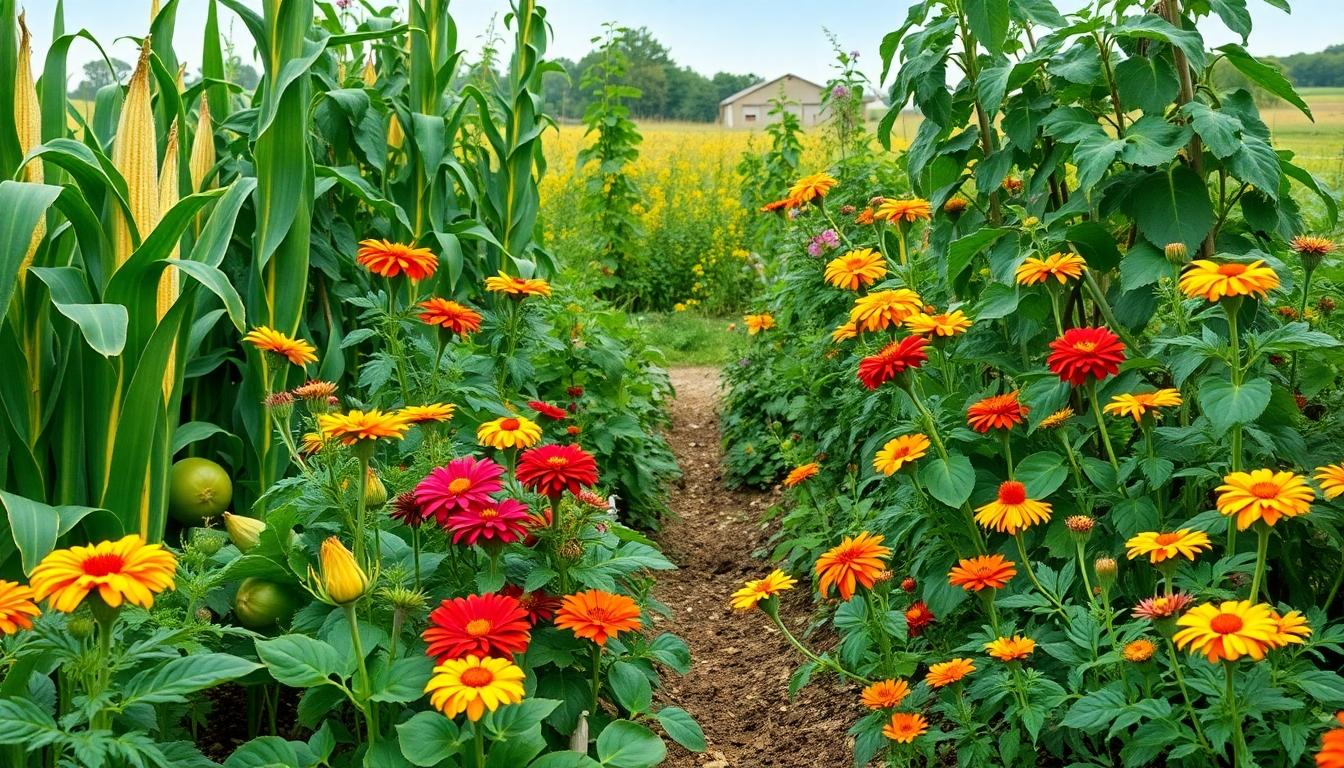
The Amish have perfected companion planting as a natural pest management strategy in their gardens. This time-tested approach strategically pairs plants to create a balanced network that naturally deters unwanted insects while promoting healthy growth.
Beneficial Plant Combinations That Deter Pests
The “Three Sisters” method represents one of the most effective plant partnerships in Amish gardening. Corn, beans, and squash planted together create a mutually beneficial relationship where squash leaves naturally suppress weeds while beans fix nitrogen in the soil. Tomatoes thrive when paired with basil, which effectively repels harmful whiteflies and other tomato pests. Nasturtiums serve as excellent trap crops for aphids when planted near beans, drawing these pests away from your valuable crop. Marigolds, zinnias, and roses work together to combat persistent Japanese beetles and aphids from damaging your garden. Many Amish gardeners plant mustard and geraniums throughout their gardens because their strong scents naturally deter various insect pests. Calendula offers dual benefits by attracting essential pollinators while simultaneously repelling aphids from nearby plants. Careful planning is necessary, as certain combinations like carrots planted near dill or parsley can inhibit growth rather than promote it.
Growing Herbs As Natural Insect Repellents
Basil serves as more than just a culinary herb in Amish gardens, disrupting pest activity when planted among tomato plants. Mint effectively deters rodents and ants from garden areas, though Amish farmers always contain it in dedicated spaces to prevent its aggressive spread. Sage attracts beneficial predatory insects that naturally prey on common tomato pests, creating a balanced network. Aromatic herbs like lovage hold special importance in Amish gardening traditions due to their powerful pest-repellent properties. Rosemary doesn’t just enhance recipes but also functions as a natural insect deterrent throughout the garden. These herb companions work alongside other organic practices like soil enrichment with compost and eggshells that deter slugs while adding calcium to the soil. Traditional crop rotation techniques further disrupt pest life cycles, while the use of heirloom seeds promotes the biodiversity essential for natural pest resistance.
| Primary Crop | Companion Plant | Pest Targeted |
|---|---|---|
| Beans | Nasturtiums | Aphids |
| Tomatoes | Basil | Whiteflies |
| Roses | Zinnias | Japanese Beetles |
| Squash | Marigolds | Nematodes |
Conserving Water Through Traditional Irrigation Methods
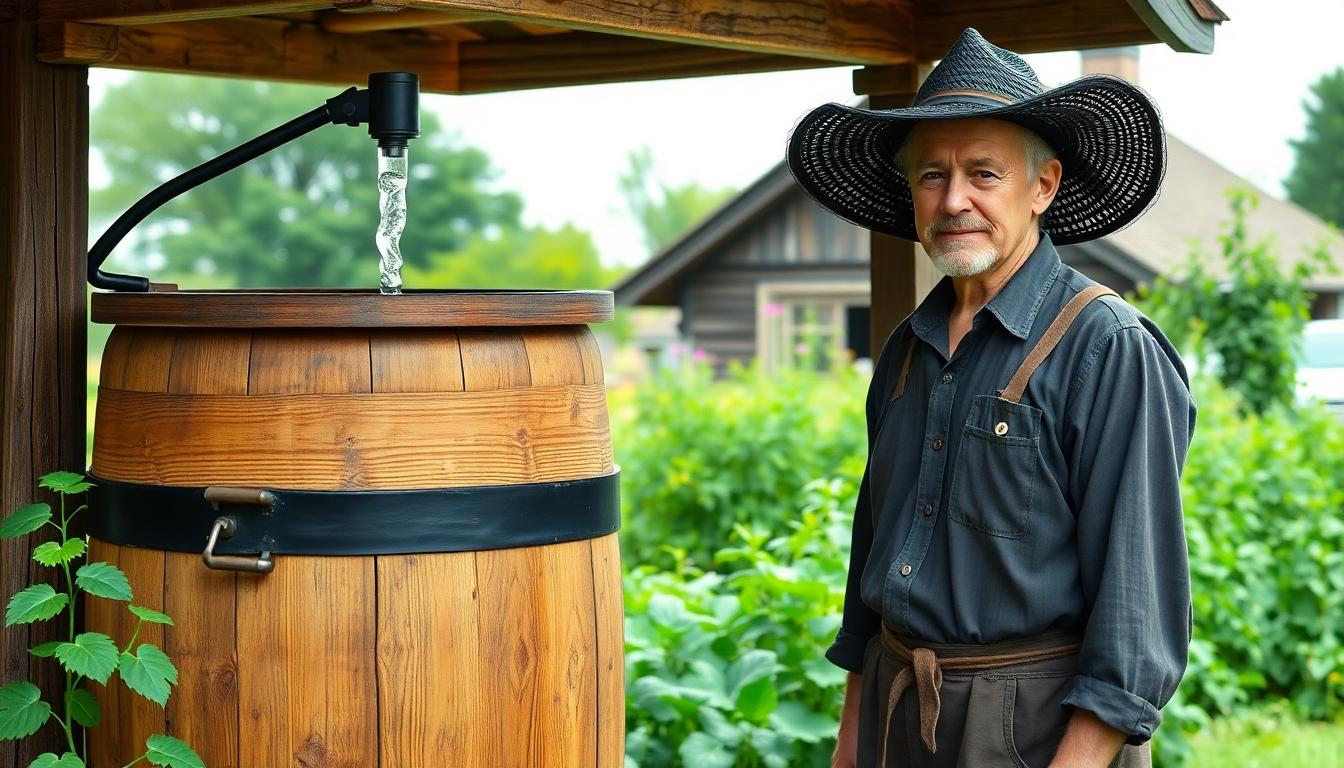
The Amish have perfected water conservation techniques through centuries of sustainable farming practices. Their traditional irrigation methods focus on utilizing natural resources efficiently while minimizing energy consumption and environmental impact.
Building Effective Rain Collection Systems
Amish farmers excel at harvesting rainwater through strategically designed collection systems. They typically place large barrels, cisterns, or underground tanks made from durable materials like wood or concrete to capture rainfall. These containers are strategically positioned under rooftops where water naturally flows during rainstorms. Many Amish communities incorporate wooden pipes sealed with natural pitch to distribute this collected water throughout their gardens. Their rain collection systems operate on a simple yet effective principle: capture water when it’s abundant for use during drier periods. This sustainable approach provides gardens with chemical-free water while reducing dependence on external water sources.
Implementing Deep Watering Techniques
Deep watering forms the cornerstone of Amish irrigation philosophy, prioritizing plant health over convenience. Amish gardeners often use buckets to manually water plants deeply but infrequently, encouraging roots to grow downward in search of moisture. This methodical approach promotes stronger root development and creates more drought-resistant plants compared to shallow, frequent watering. Plants watered with this technique develop extensive root systems that access soil moisture even during dry spells. Gravity-fed irrigation systems further enhance their water conservation efforts, utilizing elevated water storage placed on hillsides or platforms. Water flows naturally downward through the garden without requiring pumps or electricity, demonstrating how effectively traditional methods can conserve both water and energy while maintaining thriving gardens.
Extending The Growing Season With Simple Structures
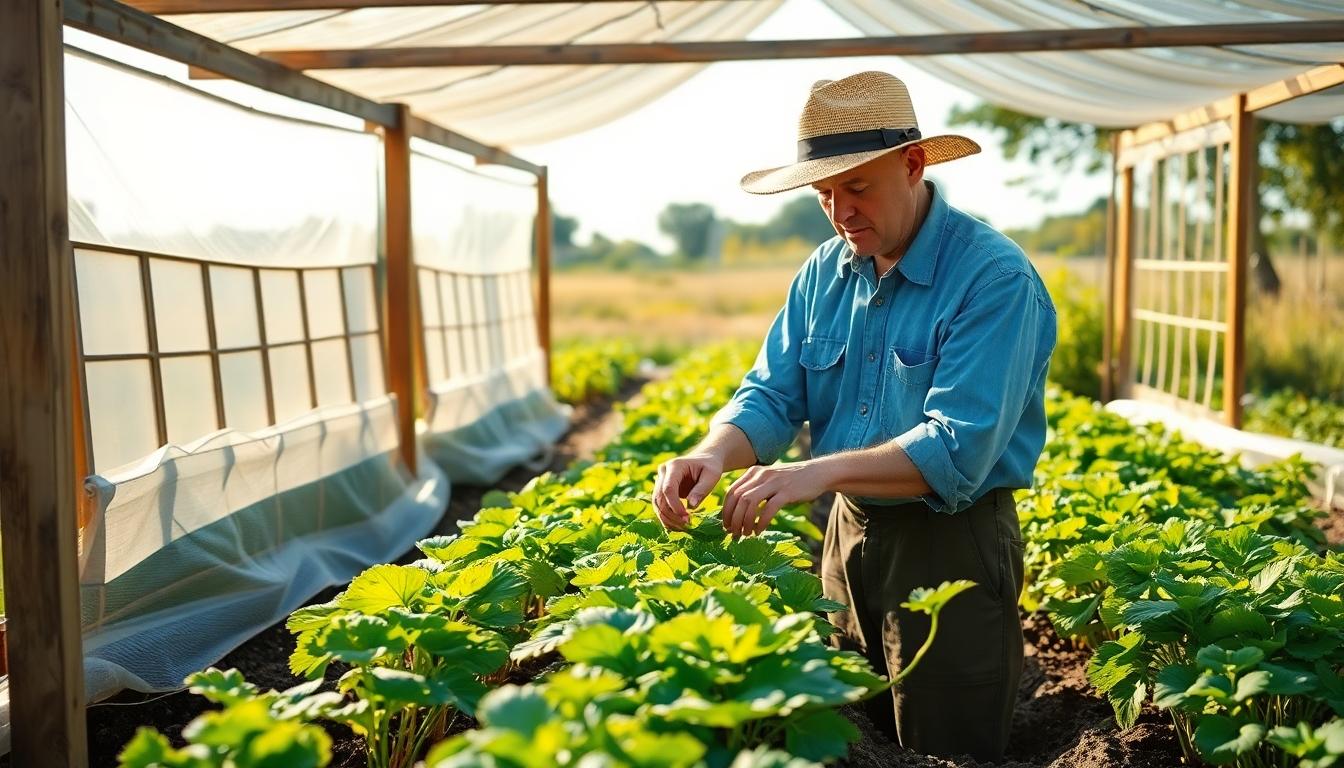
Amish farmers have mastered the art of extending their growing seasons without relying on modern technology. Using simple, electricity-free structures like cold frames and hoop houses, they create protective microclimates that effectively move plants 500 miles south or up to 1.5 USDA growing zones warmer. These traditional methods allow for continued harvests well into the colder months, even in harsh northern climates.
Constructing Cold Frames Without Electricity
Cold frames offer an excellent solution for extending your growing season using simple materials and traditional wisdom. Cedar makes an ideal choice for the frame due to its natural rot resistance, though pine or spruce can work well if you include replaceable base strips where rot is most likely to occur. Avoid using pressure-treated lumber as toxic chemicals can leach into your soil and affect your plants.
The most effective design features a sloped box that captures maximum sunlight—typically 8-12 inches tall at the front with a taller back. Standard 8-foot boards work perfectly for constructing these protective environments. For the transparent top, salvaged windows provide a durable, long-lasting cover that traps heat effectively. Alternatively, plastic sheeting supported by PVC tubing offers a lightweight, affordable option that’s easier to handle and replace when needed.
Using Row Covers To Protect Young Plants
Row covers provide essential protection for vulnerable seedlings against both frost damage and persistent pests. These lightweight fabrics or plastic sheets create a protective barrier while still allowing sunlight, water, and air to reach your growing plants. Installation requires minimal effort—simply drape the material over your plants and secure the edges with soil, rocks, or specialized clips.
Hoop houses represent a larger-scale version of this protection method, perfect when you need to shield entire garden rows or beds. Constructed from bent PVC pipes or metal conduit covered with plastic sheeting, these structures maintain soil warmth and significantly reduce wind exposure. The beauty of both row covers and hoop houses lies in their simplicity—they require no electricity, use readily available materials, and can be easily moved or adjusted as needed throughout the growing season.
Saving Seeds And Preserving Heirloom Varieties
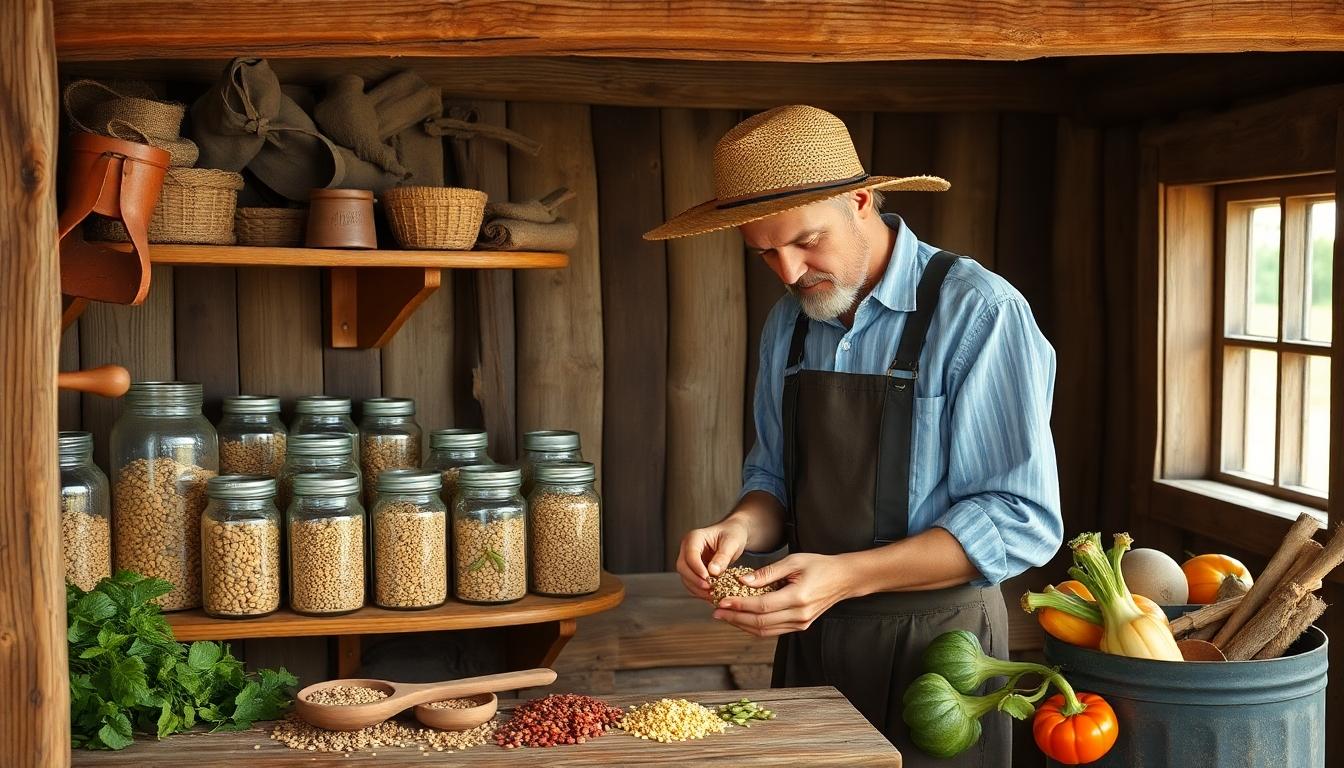
The Amish tradition of seed saving represents one of their most valuable gardening practices, ensuring genetic diversity and plant resilience through generations. These time-tested techniques preserve unique varieties adapted to local growing conditions.
Proper Seed Collection And Storage Methods
Amish farmers excel at collecting and storing seeds using methods customized to different plant types. For tomatoes and cucumbers, they use wet fermentation—extracting seeds from ripe fruits, mixing them with water, and allowing the mixture to ferment for 2-3 days. This process naturally breaks down the germination-inhibiting gel coating surrounding the seeds, significantly improving sprouting rates. Beans and peas require dry processing, where pods are thoroughly air-dried before carefully shelling and storing in breathable cloth bags until completely moisture-free.
Long-term storage demands special attention, with Amish gardeners placing fully dried seeds in airtight containers like glass jars or moisture-proof bags. Many add silica gel packets to control humidity levels and store their seed collections in cool, dark environments such as cellars or root cellars. The selection process focuses exclusively on seeds from the healthiest and most robust plants, ensuring only the strongest genetic traits continue to the next growing season.
Maintaining Plant Diversity For Garden Resilience
Amish communities prioritize heirloom variety preservation through several strategic practices that maintain genetic diversity. Self-pollinating crops like beans, lettuce, and peas receive special attention since they minimize cross-pollination risks while preserving varietal purity. Experienced Amish gardeners regularly rotate their seed stock, periodically replanting older seeds to test viability and ensure continuous adaptation to changing soil conditions and weather patterns.
Community seed exchanges form a crucial element of Amish agricultural resilience. These networks of farmers share seeds within their communities, effectively widening the genetic pool and reinforcing crop hardiness across different growing conditions. This collective approach to seed preservation creates an informal but highly effective seed bank that maintains rare varieties that might otherwise disappear from commercial cultivation. Plants selected for seed saving typically demonstrate optimal yield, superior flavor, and natural disease resistance—traits that commercial seed producers often sacrifice for shelf life or shipping durability.
Incorporating Work-Saving Garden Layout Designs
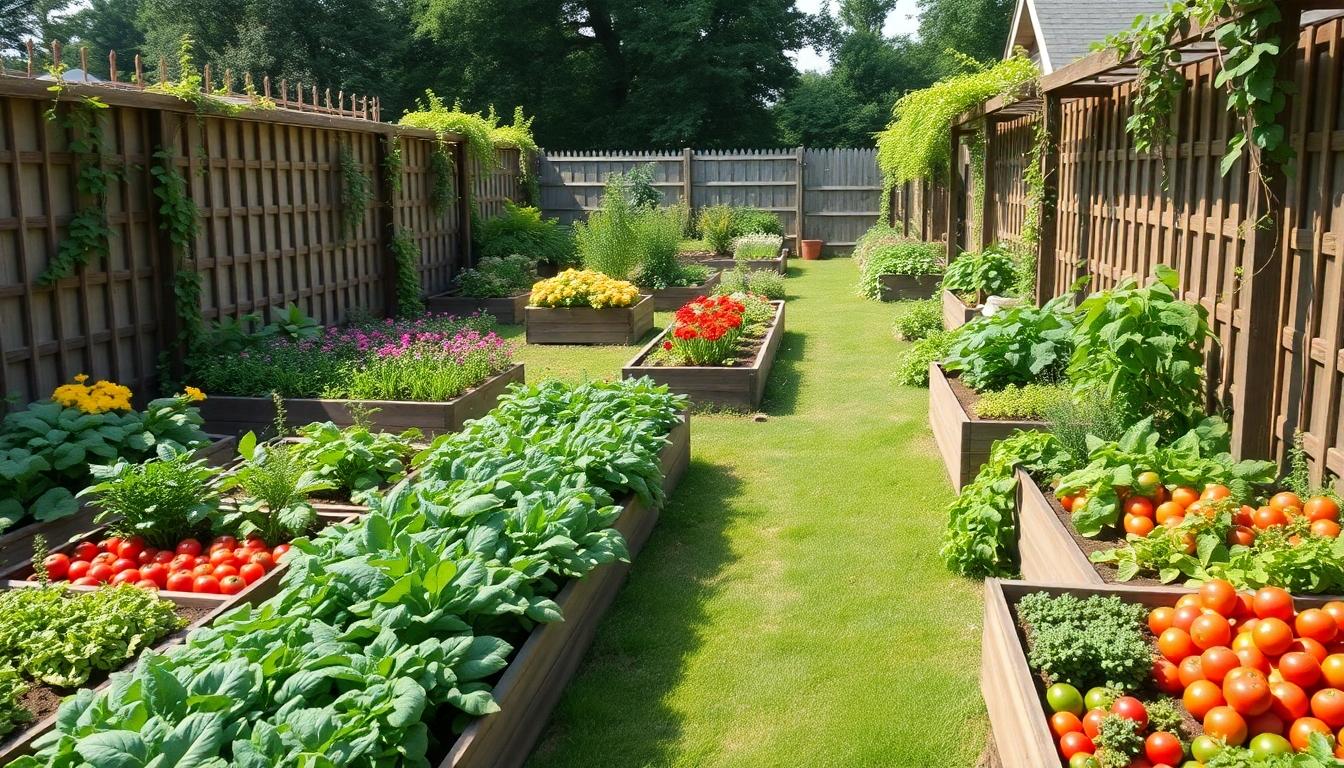
Amish farmers have perfected garden layouts that maximize productivity while minimizing labor. These time-tested designs focus on efficient use of space and natural growing patterns to create gardens that practically maintain themselves.
Panels and Grids
Amish gardens typically feature square panel layouts, measuring 55 or 66 feet square, divided into manageable sections. This systematic approach allows for better organization and easier maintenance of different plant varieties. We’ve found that these grid systems make crop rotation, harvesting, and general garden management significantly more efficient throughout the growing season.
Vertical gardening techniques are widely employed in Amish communities to maximize limited space. Their multi-level growing systems use climbing beans and vining plants that grow upward rather than outward. We recommend implementing these vertical strategies to double or even triple your growing area without expanding your garden’s footprint.
Creating Efficient Planting Rows and Pathways
Amish gardeners maintain narrow paths between planting beds, typically just 1.5 to 2 feet wide. These pathways remain weed-free through regular hoeing or by covering them with organic materials like sawdust or tanbark. We’ve seen how these narrow walkways maximize growing space while still providing necessary access to all plants.
Raised beds elevated 6 to 8 inches above pathways form the foundation of Amish garden design. This elevation creates natural drainage systems and allows soil to warm more quickly in spring. Plants in these raised beds benefit from improved root development and reduced soil compaction from foot traffic.
Intensive spacing techniques place plants closer together than conventional gardening methods recommend. This approach creates natural shade that suppresses weeds and conserves soil moisture. We’ve observed how this dense planting strategy produces higher overall yields while requiring smaller, more manageable daily harvests.
Designing Gardens for Minimal Maintenance
The Three Sisters method exemplifies Amish wisdom in garden design, combining corn, beans, and squash in a symbiotic relationship. Corn provides natural support for climbing beans, while beans fix nitrogen in the soil, and squash’s broad leaves shade the ground to reduce weeds and conserve moisture. This integrated planting approach enhances soil fertility and provides natural pest resistance.
Low-input materials like wood fences and stone walls serve as efficient garden borders in Amish communities. These natural boundaries require minimal maintenance while defining garden spaces and sometimes offering protection from animals. We recommend using locally available materials for garden borders to reduce costs and environmental impact.
Vertical training of cucumbers, melons, and other vining crops saves important garden space while making harvesting much easier. Amish gardeners use simple trellises and supports to keep fruits off the ground, preventing rot and pest damage. Training plants to grow upward rather than outward conserves valuable garden space and improves air circulation around plants.
Harvesting And Preserving The Amish Way
These Amish gardening practices aren’t just productive—they’re groundbreaking. By embracing companion planting natural fertilizers water conservation and heritage seed saving we’re reconnecting with agricultural wisdom that has sustained communities for generations.
We’ve seen how these methods create not just abundant harvests but also resilient gardens that work with nature rather than against it. The beauty of Amish techniques lies in their simplicity and effectiveness without relying on modern chemicals or equipment.
As we carry out these time-tested practices in our own gardens we’ll discover not only healthier produce but also a deeper connection to the land. The Amish approach reminds us that sometimes the most innovative answers are those that have been quietly working for centuries.
Frequently Asked Questions
What are the key sustainable gardening techniques used by Amish farmers?
Amish farmers rely on seven key techniques: companion planting for natural pest control, organic fertilizers and soil amendments, water conservation methods, manual cultivation with hand tools, season extension techniques, seed saving of heritage varieties, and natural pest management strategies. These methods have been refined over generations to work with nature rather than against it.
How do Amish farmers manage pests without chemicals?
Amish farmers use strategic companion planting (like marigolds with tomatoes), diatomaceous earth, and homemade soap sprays to control pests naturally. They also rely on beneficial insects and birds for pest control. These non-toxic methods effectively manage garden pests while maintaining ecological balance and avoiding harmful chemical residues on food crops.
What is the “Three Sisters” method mentioned in the article?
The “Three Sisters” is a traditional companion planting method where corn, beans, and squash are grown together. The corn provides support for climbing beans, beans fix nitrogen in the soil benefiting all plants, and squash spreads along the ground, suppressing weeds and retaining soil moisture. This symbiotic relationship maximizes garden space and productivity.
How do Amish farmers conserve water in their gardens?
Amish farmers use rain collection systems with barrels and cisterns, practice deep but infrequent watering to encourage strong root growth, and implement gravity-fed irrigation systems. These methods minimize water waste, promote drought resistance in plants, and maintain garden productivity even during dry periods without relying on electric pumps.
What are cold frames and how are they used?
Cold frames are simple structures with transparent tops that create protective microclimates for plants. Amish farmers use them to extend growing seasons by shielding plants from frost and cold weather. Built with rot-resistant wood and clear tops to admit sunlight, cold frames allow for earlier spring planting and later fall harvests without electricity.
How do Amish farmers maintain soil health?
They focus on organic methods including composting organic materials with animal manure in layers, applying aged livestock manure (particularly from cattle and poultry), practicing crop rotation to prevent soil depletion, and avoiding synthetic chemicals. These practices build soil structure, enhance fertility, and promote beneficial soil organisms.
Why is seed saving important in Amish gardening?
Seed saving preserves genetic diversity, ensures plants are adapted to local conditions, and maintains resilient, flavorful heirloom varieties. Amish farmers collect seeds using methods like wet fermentation for tomatoes and dry processing for beans, store them properly for viability, and participate in community seed exchanges to enhance crop diversity and hardiness.
What garden layout designs do Amish farmers use to save work?
Amish farmers design gardens with square panels for organization, vertical elements to maximize space, narrow pathways for easy access while maximizing growing area, and raised beds for improved drainage. They also use intensive spacing techniques for higher yields and simple, low-input materials for garden borders to minimize maintenance while optimizing productivity.
How do Amish farmers extend their growing seasons?
Besides cold frames, they use row covers to protect seedlings from frost and pests, and construct hoop houses to shield entire garden rows. These simple, electricity-free structures create protected microclimates that allow continued harvests into colder months, effectively extending the growing season even in harsh northern climates.
Can modern gardeners easily adopt these Amish techniques?
Yes, modern gardeners can readily implement these time-tested Amish techniques. The methods require few specialized tools or materials and focus on working with natural processes. By adopting companion planting, organic soil management, water conservation, and natural pest control, anyone can create more sustainable, productive gardens regardless of their gardening experience.







